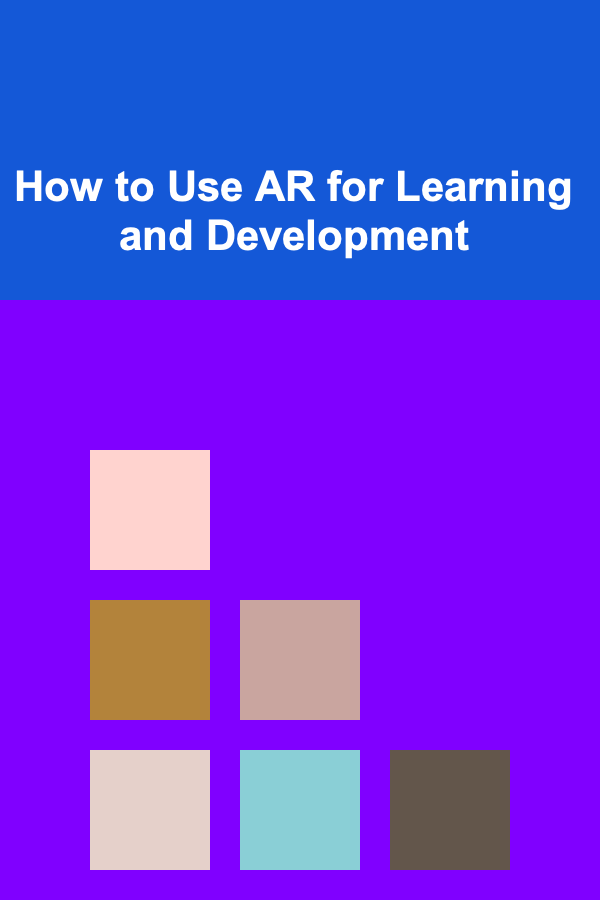
How to Use AR for Learning and Development
ebook include PDF & Audio bundle (Micro Guide)
$12.99$7.99
Limited Time Offer! Order within the next:

Augmented Reality (AR) has emerged as a transformative technology in various fields, and its potential for learning and development (L&D) is immense. By overlaying digital information---such as text, images, sounds, or 3D models---onto the real world, AR creates an immersive experience that can enhance the way people learn. In this article, we will explore how AR can be applied in learning and development, its benefits, challenges, and best practices for implementation.
Understanding Augmented Reality (AR)
At its core, Augmented Reality is a technology that blends the physical world with digital content. Unlike Virtual Reality (VR), which completely immerses users in a simulated environment, AR enhances the user's interaction with the real world by adding layers of digital elements. This can be experienced through smartphones, tablets, smart glasses, or AR headsets, which display interactive content overlaid on the user's environment.
In the context of learning and development, AR offers numerous possibilities to improve engagement, retention, and accessibility, providing learners with interactive and visually appealing experiences that traditional learning methods cannot match.
Why AR is Important for Learning and Development
Traditional learning and development methods---whether in-class training, textbooks, or e-learning modules---have their limitations. These methods may struggle to fully engage learners, especially when complex or abstract concepts are involved. AR offers an innovative solution to many of these challenges.
1. Enhanced Engagement
AR brings a new level of interactivity to learning. By integrating multimedia content such as videos, images, and 3D models into the real world, AR encourages active participation. Learners are no longer passive recipients of information; they interact with the content in real-time. This heightened engagement helps improve focus, motivation, and interest, which are essential for effective learning.
For instance, instead of reading about the human anatomy from a textbook, learners can use an AR app to see a 3D model of the human body, rotate it, zoom in on organs, and even observe how they function. This interactive learning approach makes the experience more memorable and meaningful.
2. Personalized Learning Experience
One of the challenges of traditional education is its one-size-fits-all approach. Learners have different learning styles, speeds, and preferences, which can hinder the learning process. AR offers a personalized learning experience by allowing learners to interact with content that is tailored to their needs.
For example, an AR-based learning system could offer different levels of difficulty, interactive tutorials, or simulations that adjust based on the learner's progress. This personalized approach helps ensure that each learner receives the most appropriate content at their level, facilitating a more effective learning journey.
3. Immediate Feedback and Assessment
AR allows learners to receive immediate feedback as they interact with learning content. Whether they are solving a problem, completing a task, or exploring a 3D simulation, they can instantly see the results of their actions. This real-time feedback helps learners understand their mistakes, adjust their approach, and correct errors on the spot, promoting deeper learning and faster development.
Moreover, AR can track learners' progress and performance through data collection, providing instructors or employers with insights on how well learners are engaging with the content. This helps inform future learning interventions and identify areas that require more attention.
4. Improved Retention
Research has shown that people tend to retain information better when it is presented in a highly engaging, interactive, and visually stimulating way. AR capitalizes on this principle by transforming abstract or complex concepts into tangible, 3D experiences that learners can explore, touch, and manipulate. This immersive learning environment makes it easier for learners to retain information in the long term.
For example, a learner studying how a car engine works can interact with a 3D AR model that shows the components of the engine and how they function in real time. This hands-on approach is far more likely to be remembered than simply reading about the subject in a textbook.
5. Cost and Time Efficiency
Although developing AR-based learning tools can be initially expensive, they have the potential to save both time and money in the long run. Instead of having learners travel to physical locations for training or rely on expensive in-person instructors, AR can deliver immersive learning experiences at scale, allowing learners to engage with the content from anywhere.
In fields such as healthcare, engineering, and manufacturing, AR can simulate real-life scenarios, enabling learners to practice skills and solve problems without the need for expensive equipment or training facilities. For instance, AR can simulate complex surgeries for medical students, allowing them to practice without putting patients at risk.
Key Applications of AR in Learning and Development
1. Corporate Training
In corporate training, AR can be used to create realistic simulations of real-world scenarios, helping employees acquire practical skills in a risk-free environment. For example, employees in fields like manufacturing or logistics can use AR to interact with virtual tools or machinery, helping them understand complex processes and workflows without the need for physical equipment.
AR can also assist in soft skills training, such as leadership or customer service. Employees can participate in immersive role-playing scenarios where they can practice communication, problem-solving, and decision-making skills in a controlled, virtual setting.
2. Healthcare and Medical Training
In the healthcare industry, AR holds particular promise for medical training and education. AR can be used to overlay 3D models of human anatomy over a learner's real-world environment, allowing medical students and practitioners to study complex structures and processes in detail. This can be particularly helpful for visualizing surgeries, understanding anatomical relationships, and training for emergency procedures.
Additionally, AR can help healthcare professionals stay up-to-date with new technologies or procedures by providing interactive tutorials and demonstrations in real time, enhancing their hands-on learning experience.
3. Military and Defense Training
The military and defense sectors have long been at the forefront of adopting new technologies for training purposes, and AR is no exception. AR can be used to simulate combat situations, allowing soldiers to practice battlefield tactics, navigation, and decision-making without the need for live exercises. For example, AR glasses could display critical information such as maps, enemy locations, and mission objectives while soldiers are out in the field, helping them make better decisions in real time.
Additionally, AR can be used to train soldiers in the operation of various equipment, such as tanks, weapons, or aircraft, by simulating realistic environments and situations. This reduces the need for costly physical training resources and ensures that soldiers are well-prepared for real-world scenarios.
4. Education and K-12 Learning
In schools and universities, AR can enhance traditional learning by making abstract concepts more tangible. For example, instead of reading about historical events, students can use AR to interact with 3D models of historical artifacts, buildings, or figures. This brings history to life in a way that textbooks alone cannot achieve.
AR can also be used to teach complex scientific concepts. Students learning about the solar system, for example, can use AR to explore planets in three dimensions, understanding their size, distance from the sun, and unique characteristics. This hands-on approach makes science more engaging and helps students grasp difficult concepts more easily.
5. Retail and Customer Experience Training
AR can also be used in retail environments to train employees in customer service, product knowledge, and sales techniques. For example, retail employees can use AR to simulate customer interactions, allowing them to practice how to handle customer inquiries, complaints, or upsell products in a realistic, virtual environment.
Furthermore, AR can be used to provide customers with a more personalized shopping experience. Through AR apps, customers can try on clothes virtually, visualize how furniture would look in their homes, or even get detailed information about a product by scanning it with their smartphones.
Challenges in Using AR for Learning and Development
While AR offers numerous advantages, there are several challenges associated with its implementation in learning and development.
1. High Development Costs
One of the main barriers to the widespread adoption of AR for L&D is the high cost of developing AR-based learning tools. Creating AR content requires specialized expertise in software development, 3D modeling, and user experience design. Additionally, the hardware required to run AR applications---such as smart glasses, tablets, or smartphones---can be expensive, especially if an organization needs to equip a large number of employees or learners.
2. Technical Limitations
While AR technology has advanced significantly, it is still not without its technical challenges. For instance, AR applications require powerful hardware and reliable connectivity to work smoothly. In environments with limited internet access or outdated devices, AR tools may not function optimally, hindering their effectiveness as a learning tool.
Additionally, AR experiences can sometimes be disorienting or cause motion sickness for some users, which can negatively impact the learning experience. Designers must carefully consider the user interface and interactions to ensure that AR content is accessible and comfortable for all learners.
3. Content Development and Scalability
Another challenge is the development of high-quality, scalable AR content. While some industries have developed robust AR applications, others are still in the early stages of exploring how AR can be used effectively in learning and development. Developing AR content for specific industries, subjects, or skill sets requires a deep understanding of the content and instructional design principles.
Additionally, creating AR content that is both engaging and educational requires a thoughtful balance between entertainment and pedagogy. Overloading the learner with too much interactive content or visual stimulation can overwhelm them, detracting from the overall learning experience.
Best Practices for Implementing AR in Learning and Development
To successfully integrate AR into learning and development programs, organizations should follow these best practices:
1. Define Clear Learning Objectives
Before implementing AR, it is crucial to define the learning objectives and outcomes. What skills or knowledge should learners gain from the AR experience? Are there specific behaviors or competencies that need to be developed? By clarifying the learning goals upfront, organizations can create AR content that is focused, purposeful, and aligned with their educational objectives.
2. Focus on User Experience
The success of AR in learning and development depends heavily on the user experience. AR applications should be intuitive, easy to navigate, and engaging. Learners should feel comfortable interacting with the AR content, and the technology should enhance, not hinder, the learning process. Regular user testing and feedback can help identify any usability issues and ensure that the AR experience is smooth and effective.
3. Integrate AR with Existing Learning Platforms
Rather than creating standalone AR applications, organizations should look for ways to integrate AR into existing learning management systems (LMS) or other learning platforms. This will streamline the learning process and allow learners to seamlessly transition between different types of content, whether it's AR-based modules, e-learning courses, or instructor-led training.
4. Start Small and Scale Gradually
Given the technical and financial challenges of implementing AR, organizations should start with small, pilot projects. This will allow them to test the feasibility of AR for their specific learning objectives, identify potential problems, and gather feedback from learners. Once the pilot has proven successful, the program can be scaled to a larger audience or expanded to include additional content.
5. Provide Ongoing Support and Training
To maximize the effectiveness of AR in learning and development, organizations should provide ongoing support and training for both learners and instructors. Learners should be given clear instructions on how to use AR tools effectively, and instructors should be trained on how to incorporate AR into their teaching methods.
Conclusion
AR is poised to revolutionize the field of learning and development. By offering immersive, interactive, and personalized experiences, AR can enhance engagement, improve retention, and provide learners with practical skills in a risk-free environment. However, organizations must overcome challenges such as high development costs, technical limitations, and content scalability to fully realize the potential of AR in L&D.
With careful planning, thoughtful implementation, and ongoing support, AR can become a valuable tool for creating effective and innovative learning experiences that meet the needs of today's learners and tomorrow's workforce.

How to Manage Your Time Effectively While Working Remotely
Read More
How To Wear Animal Print Tastefully
Read More
Insurance Agent's Handbook: Effective Techniques for Closing Deals and Growing Your Business
Read More
How to Understand the Concept of Sacrifice in Mythology
Read More
Exploring EV Battery Recycling and Sustainability
Read More
10 Tips for Growing Herbs in Small Spaces for Crafting
Read MoreOther Products

How to Manage Your Time Effectively While Working Remotely
Read More
How To Wear Animal Print Tastefully
Read More
Insurance Agent's Handbook: Effective Techniques for Closing Deals and Growing Your Business
Read More
How to Understand the Concept of Sacrifice in Mythology
Read More
Exploring EV Battery Recycling and Sustainability
Read More